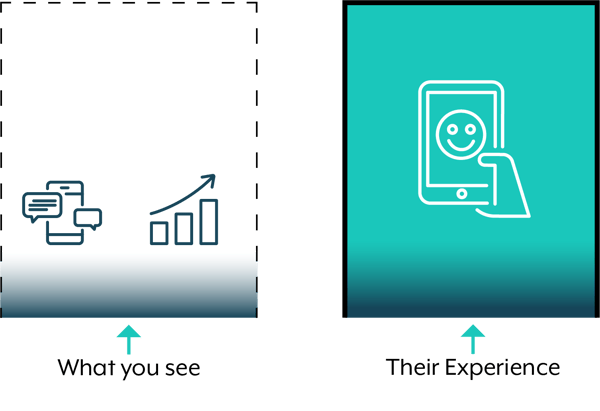Connecting to your audience is not easy. Today’s digital world has everyone living through their devices, so how do you capture attention among the mountains of content that’s out there?
|
What's in this article: Applying empathy to your CPG marketing strategy The Do’s and Don’ts of empathy marketing |
Information overload is real. And marketers scramble to innovate, to find new ways of reaching the people they are trying to help – aiming to tap within and get through to their audience. With multiple channels presenting more opportunities to reach and communicate, what makes people pay attention?
You know your solution works, so maybe the real question to ask is “How do I earn the attention of the people I’m looking to help?” Connecting and building trust is not an option—it's imperative. People are emotional creatures.
This is why empathy marketing matters.
What is empathy marketing?
Empathy is inherently one of the most important components of emotional intelligence. The core of empathy marketing is listening with the intention of deep understanding.
In other words, if your content or product isn’t hitting the mark, the answer could come down to a lack of empathy for (listening to) your audience. Consider this 2019 Forrester report which found that 59% of purchase decision-makers feel the content they come across by vendors is useless, while 70% believe it lacks substance.
Especially after COVID-19, people don’t want to feel like they’re being “sold” to. Empathy marketing brings a human element to marketing campaigns that most marketers tend to overlook.

Why is it important?
Oftentimes content speaks at people. It tries to cut through the noise by using pretty colors or sounding relatable to a certain generation. And it probably works for your awareness campaigns. While that might attract attention, however, it doesn’t always translate to resonance with the people who would best align with your mission. Empathy marketing puts human connection at the basis of your strategies and your products.
Data matters a great deal in any marketing campaign. It will also serve you as you approach your empathy marketing strategy —which we will cover later in the next. But first, here’s some food for thought from Noah Fenn's article on empathy marketing, “After all the CPMs are calculated and the analytics interpreted, empathy is still the greatest tool in a marketer's toolbox...Can we really know what consumers prefer if we haven't given them much of a choice?"
TLDR: It is a customer-centric approach that aims to make people feel seen, valued, and understood —which is exactly what empathy does.
Applying empathy to your CPG marketing strategy
After COVID-19 hit, many companies in the CPG industry had to reinvent their marketing strategies. There are many ways CPG brands can instill empathy in their marketing efforts, and it's never too late to start.
So what can marketers do to tactically instill empathy in their day-to-day roles? How can they really put their audience first so as to respect their wants and experiences?

Use your existing data! Marketers have large amounts of data at their disposal through their own tools or outside research. Use this information to put yourself in your consumer's shoes. Your brand story, content marketing efforts, and customer service are great places to highlight when starting this journey.
However, it’s important to note that your audience is more than the data points on a screen, and it will likely take many hours of interviews, social conversations, and DMs to get a deep understanding of your target audience. This section will review some of those data points that will guide you towards a deeper understanding of your consumer.
Understand demographics first, then psychographics
Demographics are the foundation of consumer research. They get at the most basic aspects of understanding your customer: Age, gender, ethnicity, location, income, profession, etc. This is crucial to instilling empathy in your marketing because even the slightest change in the demographic profile can completely change the experiences and lifestyle of the consumer. The way you communicate with a white elderly audience will be very different from how you communicate with a Black teenage community.
Psychographics are the attitudes, habits, and values that impact your consumers’ day-to-day lives. They can provide insight into how your audience perceives the world and why they buy what they buy. There may be an underlying belief system that drives your consumers to buy from you over someone else. Psychographics help you uncover that insight. It also allows you to put yourself in their shoes.
Examples of psychographics:
- What is stressing your consumer out?
- How do they manage stress?
- Do they prioritize a healthy lifestyle?
- Is family important to them?
- Do they prefer shopping in-store or online?
Psychographics help you build stronger connections with your audience by really getting at the ‘why’ behind their decisions. This helps marketers better position their products to speak to those values and belief systems. More importantly, this helps marketing teams craft a better depiction of their audience that will be the bedrock of an empathetic marketing strategy.
Bring empathy to product development
Your CPG products exist to serve your consumers. Your data lets you know which products they are buying most and how it fits into their life. We all know there is risk involved in anything new, but to stay relevant, continuously innovate your products. If an innovation team is comprised of marketers and strategy-forward people with some familiarity with empathy marketing, you can make a great consumer-based product.
Think about Lay’s potato chips and Ben & Jerry’s ice cream. Every year they come up with new flavors based on what customers want and run new flavor competitions for their consumers to participate in.
Marketing your brand messaging... consistently
Beyond having a product that meets customer needs and knowing who you are selling to, brands need to know how to best communicate. Empathetic messaging means taking into account who you’re talking to with every word. If your core customers live in a city, then brand messages shouldn’t target the pain points of rural life, for example.
Once you’ve established the style your customers respond to, stick with it! Frequently changing your messaging to try to attract attention comes off as click-bait. Part of being an empathetic brand is being consistent with your audience. Customers will become familiar with your brand’s voice, and meeting their expectations of you maintains this relationship.
.png?width=600&name=Q221_BG_Empathy%20Marketing_Graphic-2%20(1).png)
The Do’s and Don’ts of empathy marketing
Every brand will approach empathy marketing a little differently. There are, however, a few tips everyone can consider. These Do’s and Don'ts come from our interview with Pat Timmons, author of Feel Something - a book about the importance of empathy for marketers. You can read the full interview down below or by clicking here.
Do:
- Listen to your audience
- Be constantly curious about your audience’s needs and emotions
- Talk to your audience live! Ask them questions about your product/service. What do they love? What do they hate? Where do they need support? Your marketing should meet them where they are.
Don’t:
- Make your content all about you
- Try to come off as empathetic when your organization does not actually stand for the cause you are discussing. AKA walk the walk.
- Assume anything.
How are brands showing empathy in their marketing strategies?
To provide some examples, here are a few well-known CPG brands using empathy marketing
Ben & Jerry’s: They not only look to their customers for new flavor ideas, but they also remain active in the political landscape. Aside from providing recipes, their content marketing strategy consists of social activism that maintains a positive brand and reputation.
Tide: Being around for 75 years has given Tide plenty of insight into its consumers. They’ve been around to see generations grow up. Tide knows consumers care about sustainability. They created a page on their website dedicated to sustainability and tips on how to conserve energy.
Chobani: Aside from yogurt, their product line has evolved to include zero sugar options, oat milk, and probiotics supplements. The Greek yogurt brand prides itself on understanding its consumers’ needs for healthy food and the health of the planet. They dedicate themselves to the impact that food has on the environment, stating “It’s always been about more than yogurt.” and “Committed to making our yogurt better for the earth." They even go as far as to provide public impact reports. A recent Twitter post continues to prove their dedication.
Click here to see Chobani’s full Twitter post and watch the video.
Think about how you want to be marketed to
To provide another point of context from Noah Fenn’s AdAge article, “The people we're trying to reach are shouting the solution back at us in the form of data. We just need to learn how to listen to them and respond accordingly with creativity, innovation and choice.”
Don’t forget that you yourself are a consumer - or rather, a human. When you create your strategies do you think about the person behind the screen? Before hitting send on an email blast or signing off on a product description, imagine if you were the one reading that message. Think about how it would make you feel. Does it make you feel like that brand values you, or do you just feel solicited to? Remember - we’re all consumers at the end of the day.
Interview with Pat Timmons, author of Feel Something
Empathy marketing is still a nascent topic amongst industry practitioners. More and more people are understanding the importance of instilling empathy in their work. This has immense implications to create a more thoughtful and understanding world.
Pat Timmons, who also works in social media at Webflow, explores this topic and identifies numerous insights and tactics for marketers. Timmons states the book “speaks to marketing practitioners and leaders who want to look at traditional marketing and audience growth in a new way.” The book’s Indiegogo page has since closed and exceeded its funding goal by over 100%.
If you’re interested in empathy marketing, you can subscribe to Pat’s newsletter here.
Here is our full interview with Pat Timmons:
Brightfield: What industries are at the forefront of empathy marketing?
Timmons: Honestly, I think that the food / snack industry is leading the way with empathy marketing. All across social, we are seeing a ton of brands like Velveeta, McDonalds, Oreo, Chipotle, and more embrace a human voice. Their content is relatable, entertaining, and in some cases extremely nostalgic.
This strategy makes people feel something strong towards the brand and increases brand affinity.
Brightfield: Do you have some good examples of brands doing this well?
Timmons: As mentioned above, I think food brands are doing great, but if I had to choose one, I’d choose McDonald’s. Their tweets are super relevant to A. their audience’s emotions, B. current events, and C. their brand experience.
Brightfield: How do you balance data and empathy in marketing?
Timmons: Data can be a great tool for determining what is successful, or not. It draws the lines for you, but it can never provide the full color you need to bring empathy into your marketing. The color comes from user interviews, authentic conversations with audience members, social listening, and more.
Brightfield: What is your best tip for marketers to implement empathy in their marketing strategies?
Timmons: Always listen and always advocate for your audience in meetings. A lot of marketers are really really REALLY busy and they get caught up in the day-to-day work that comes in. When we are constantly heads-down working, we are not able to find new ways to look at the big picture and our audience's true needs; we miss way too much.
Ready to position your next product based on consumers’ needs?


